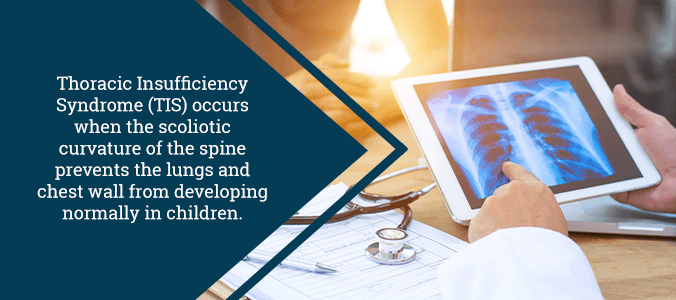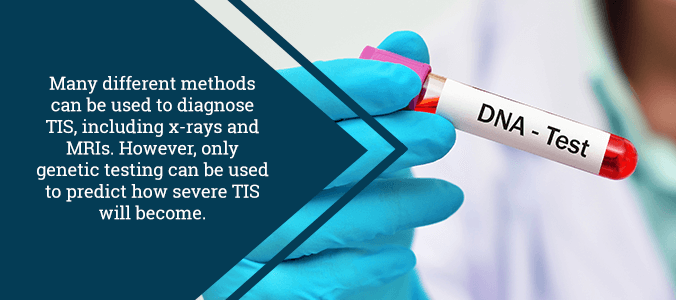Symptom WATCH: Thoracic Scoliosis & Thoracic Insufficiency Syndrome
Thoracic insufficiency syndrome (TIS) is a condition that deforms the chest wall and affects breathing and normal lung growth. In cases involving children, severe scoliosis usually accompanies the condition.
More specifically, TIS prevents the thorax from performing its normal functions. This affects a person’s ability to breath normally and causes abnormal lung growth. For context, the thorax rests between the neck and abdomen and includes other structures such as the spine and sternum. When this structure works properly, lung growth is proportional to chest and spine growth. TIS affects this relationship, stunting lung development via rib deformities and spinal curvatures (thoracic scoliosis). If left untreated, these problems will worsen as the child grows. Eventually, some children will need to be put on a special device to assist with breathing.
Thankfully, there have recently been revolutionary developments in the field of TIS treatment. Doctor and inventor Robert M. Campbell Jr. devised a special implant to resolve this condition. The device is known as the vertical expandable prosthetic titanium rib (or VEPTR). This implant is the first FDA-certified device for treatment of the condition and provides the specialized treatment needed for TIS.

Causes of Thoracic Insufficiency Syndrome (TIS)
TIS does not occur in many children, affecting fewer than 4,000 pediatric scoliosis patients in the United States. The condition is both congenital (present at birth) and progressive (worsens with time). There are many potential causes of TIS, but it shares the strongest relationship with early onset scoliosis.
In order for the thorax to play its role in the respiratory process, it must be able to alter the chest wall volume. Additionally, the thorax needs to have a certain amount of space in order for the lungs to grow properly. In TIS, thorax deformity limits the ability of the lungs and diaphragm to perform these essential breathing functions. In addition, dimensions such as volume and thoracic symmetry need to fall within a certain margin, otherwise, the structures become corrupted.
With scoliosis, thoracic volume may be lost due to spinal curves that protrude into the chest (such as hyperlordosis). The resulting loss of volume means that the ribs no longer move adequately during the respiration process. This hinders breathing, as it puts the entire load on the diaphragm muscle. If the deformity gets worse with time, so does the child’s ability to breathe normally. Eventually, the child may require a ventilator or oxygen support to make up for TIS.
Other conditions that affect the thorax and potentially lead to TIS are as follows:
- Thoracic kyphosis (hunchback)
- Rib fusion
- Ribs failing to form properly at birth
- Genetic predispositions
- Lung disorders (Ex. Jeune syndrome)
- Spinal muscular atrophy
These are just a few potential causes of TIS. Remember, even though there are many possible causes, the condition is still relatively rare. It is unlikely that your unborn child will be born with TIS.

Symptoms of Thoracic Insufficiency Syndrome (TIS)
Symptoms of TIS will vary depending on the case, as the condition shares relationships with many other medical disorders and syndromes. A general list of symptoms for TIS include:
- Spinal deformities resulting from scoliosis or kyphosis
- Severe cases of rib fusion
- Absence of ribs from birth
- Smaller rib cage and body trunk
- A body trunk and rib cage that is more narrow than normal
- Difficulty breathing/Increased respiratory rate
- Fatigue
Again, the main thing to remember here is that symptoms and accompanying problems depend on what is causing the TIS. The common thread between TIS cases is that there is some sort of impairment of the thorax. Any condition that affects this area may lead to TIS, so the symptoms naturally vary by far and wide.
Thoracic Insufficiency Syndrome (TIS) Diagnosis
A doctor will typically identify TIS rather early in a child’s life. Usually, a TIS diagnosis is made before the child is 5 years old, and always before they are 10 years old.
For a successful diagnosis, most doctors usually start in the same place—with a medical history and physical exam. In addition to this, there are a variety of tests that a doctor may perform to identify where or not TIS is present. These tests include:
- MRI: An MRI scan uses radio frequencies to reveal lung movement and allows for the observation of respiratory function.
- EOS: A special x-ray imaging technology that renders 3-dimensional models of bodily structures.
- X-rays: A common imaging technique that doctors use to view the inner structures of the body.
- Genetic Testing: Sometimes, genetic conditions lead to the onset of TIS. For this test, a doctor will take a saliva sample to identify potential causes and ailments.
- Pulmonary Function Tests: These tests measure the lungs’ overall efficiency. Pulmonary function tests monitor attributes such as how well the lungs circulate air between the environment and the body. Examples of such tests are spirometry, breath nitrogen washout, and carbon monoxide diffusion capacity.
These are the most common tests that doctors use to diagnose TIS. Because TIS shares relationships with many other medical conditions, a panel of specialists will often discuss the results with one another.

Treatments for Thoracic Insufficiency Syndrome (TIS)
There are several treatment options available for TIS, but the most common treatment comes in the form of VEPTR implants. This device is an artificial, titanium rib that expands the patient’s chest. Additionally, VEPTR addresses other problems such as spinal curvatures and instability.
A doctor must implant the VEPTR surgically into the child’s back and chest area. The device is then anchored to an appropriate area on the spine and ribs respectively. As the child grows, the doctor will need to perform an outpatient procedure to extend the device. This expansion allows the device to keep up with the body’s growth and continue to provide its much-needed benefits. In order to achieve this, the patient will receive follow-up care from the performing medical center at regular intervals. Usually, doctors perform VEPTR expansions biannually to accommodate these changes in growth. The expansion surgery is minimally invasive, using only a 1-inch incision, and the child is discharged the following day.
Once the child’s rib has been fully expanded (usually at age 10 to 16), the doctor will remove the VEPTR. In this surgery, the doctor removes the device and performs a spinal fusion. In cases where the child is missing ribs, the VEPTR device may be left in permanently to aid with structure and function.
Because TIS shares relationships with many other spinal conditions, doctors usually approach treatment in a multidisciplinary fashion. Depending on the patient’s needs, complementary treatments such as pain medication and physical therapy may help with other extreme symptoms.
If your child has TIS or any other debilitating spinal condition, please contact us at (855) 220-5966. Dr. Jason E. Lowenstein is a well-respected expert in the scoliosis treatment community and will ensure that your child receives the specialized treatment that he or she needs to resolve their case.
